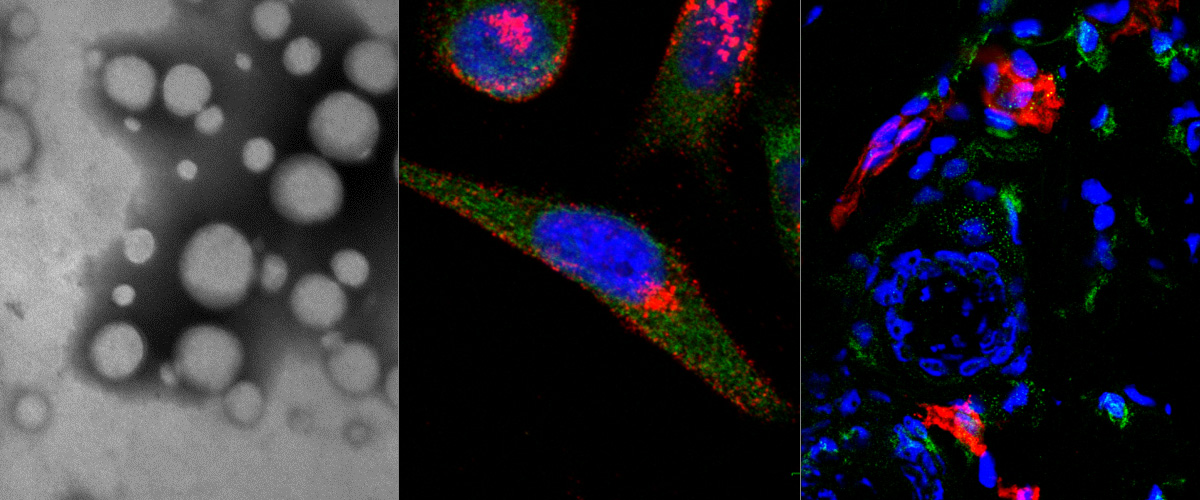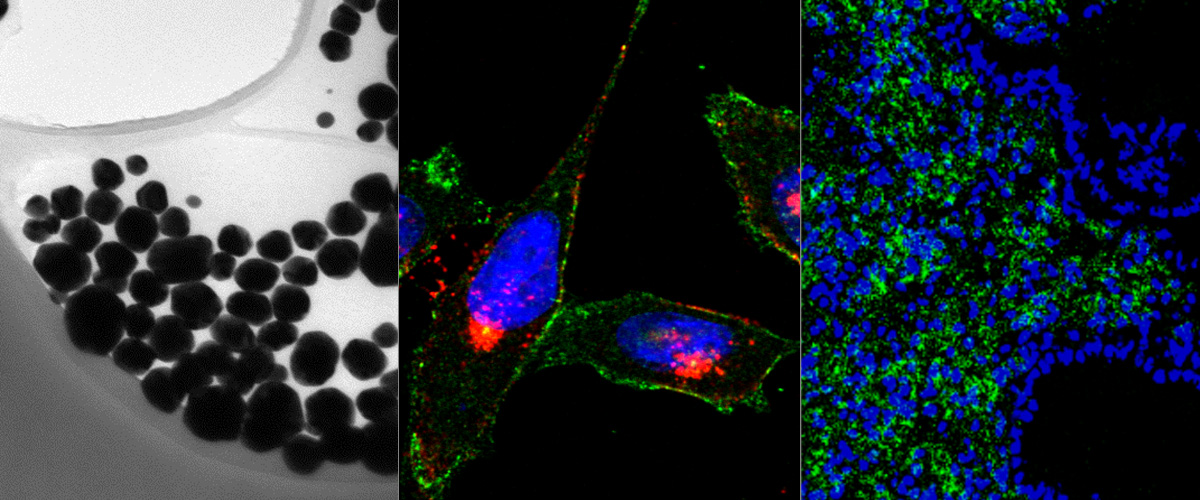Project Name: Development of tumor penetrating peptides for glioma targeting
Acronym: GliomaDDS (ERC Stg), GlioGuide (ERC PoC)
Annotation: Recently, we have identified tumor penetrating peptides (TPP) that trigger specific penetration of co-administered un-conjugated drugs deep into tumor and increase their therapeutic index. Current TPP target angiogenic tumor vessels and may not be suitable for targeting slow-growing tumors and invasive tumor cells. TPP are composed of functional modules (tumor recruitment motif, cryptic tissue penetrating C-end Rule element, and a protease cleavage site), which can be rearranged to yield peptides of novel specificities.
Our goal is to develop TPP platform for delivery of co-administered drugs to the deadliest brain tumor – glioblastoma (GBM). High-grade glioma is a target that is particularly evasive and well-suited for tissue penetrative drug delivery. We will develop glioma-specific TPP (gTPP) by combination of in vivo and ex vivo phage display of constrained peptide libraries on state-of-the-art glioma animal models. These gTPP will be able to penetrate gliomas (and potentially other tumors) independent of their angiogenic status, and to deliver drugs to infiltrating malignant cells far from the bulk glioma lesion.
We will characterize, validate, and optimize the gTPP platform for enhanced glioma delivery of co-injected drugs. These studies will provide the preclinical data needed to advance the gTPP combination therapy of glioma to GLP toxicology and subsequent IND filing.
Funding: 2012-2016; 2018
Project: EMP181 Targeting glioma stem-like cells with tumor penetrating peptides.
Project Promoter: University of Tartu, prof Tambet TeesaluProject Partner: University of Bergen, prof Rolf Bjerkvig
Project duration: 01.09.2014 - 31.12.2016
Original summary:
Our project combines the expertise of the laboratory of Prof. Rolf Bjerkvig (the state of the art, clinically relevant human GBM models) and the laboratory of Dr. Tambet Teesalu (targeted drug delivery technologies), to develop tumor penetrating peptides that target GBM. We will develop peptides that deliver payloads to infiltrative glioma stem cell-like cells by in vivo peptide phage display on advanced glioma animal models. Specifically, we will use a high-throughput DNA sequencing and bioinformatics analysis to identify peptides that home to glioma lesions and are capable of reaching the infiltrating tumor stem-like cells. We will perform mechanistic studies on peptide receptors and tissue penetration mechanisms. The peptides that we will develop are able to penetrate gliomas (and potentially other tumors) independent of their angiogenic status, and to deliver co-administered drugs to tumor propagating cells far from the bulk glioma lesion. We will characterize, validate, and optimize the tumor penetrating peptide platform for enhanced delivery of chemically conjugated and co-injected drugs. The peptides will be coupled to therapeutic payloads (low molecular-weight drug temozolomide and a therapeutic antibody) to achieve selective elimination of the malignant cells for sustained therapeutic response.
The peptides that we will develop will provide an angiogenesis-independent paradigm of tumor stem cell targeting that can be potentially applied to other types of solid tumors. As the drug does not have to be conjugated to the peptide, once a peptide has been clinically validated, it can be used to augment the efficacy of any imaging agent or anti-cancer drug - a major advance in glioma therapy could ensue.
Project status February 15, 2016
We used a high-throughput DNA sequencing and bioinformatics analysis to identify peptides that home to glioma lesions and are capable of reaching the infiltrating tumor stem-like cells. We went on to demonstrate that a synthetic tumor homing peptide, TT1, homes robustly and specifically to the glioma lesions. TT1 is a tumor penetrating peptide that targets cell-surface p32 protein that is upregulated in glioma in angiogenesis-independent manner. We have demonstrated that TT1 peptide can be used for glioma-selective delivery of nanoparticle payloads, such as iron oxide nanoworms. We are currently validating the TT1-based platform for enhanced delivery of chemically conjugated and co-administered drugs. TT1 and other peptides developed with support of this grant will allow achieving selective elimination of the malignant cells for sustained therapeutic response.
Publications acknowledging EMP181:
- Rab11 and Lysotracker Markers Reveal Correlation between Endosomal Pathways and Transfection Efficiency of Surface-Functionalized Cationic Liposome-DNA Nanoparticles.Majzoub RN, Wonder E, Ewert KK, Kotamraju VR, Teesalu T, Safinya CR. J Phys Chem B. 2016 Jul 7;120(26):6439-53. doi: 10.1021/acs.jpcb.6b04441.https://www.ncbi.nlm.nih.gov/pubmed/27203598
- Urokinase-controlled tumor penetrating peptide. Braun GB, Sugahara KN, Yu OM, Kotamraju VR, Mölder T, Lowy AM, Ruoslahti E, Teesalu T.J Control Release. 2016 Jun 28;232:188-95. doi: 10.1016/j.jconrel.2016.04.027. https://www.ncbi.nlm.nih.gov/pubmed/27106816
- New p32/gC1qR Ligands for Targeted Tumor Drug Delivery. Paasonen L, Sharma S, Braun GB, Kotamraju VR, Chung TD, She ZG, Sugahara KN, Yliperttula M, Wu B, Pellecchia M, Ruoslahti E, Teesalu T. Chembiochem. 2016 Apr 1;17(7):570-5. doi: 10.1002/cbic.201500564. https://www.ncbi.nlm.nih.gov/pubmed/26895508
- Synthesis of linear and cyclic peptide-PEG-lipids for stabilization and targeting of cationic liposome-DNA complexes. Ewert KK, Kotamraju VR, Majzoub RN, Steffes VM, Wonder EA, Teesalu T, Ruoslahti E, Safinya CR. Bioorg Med Chem Lett. 2016 Mar 15;26(6):1618-23. doi: 10.1016/j.bmcl.2016.01.079. https://www.ncbi.nlm.nih.gov/pubmed/26874401
- Targeted silver nanoparticles for ratiometric cell phenotyping. Willmore AM, Simón-Gracia L, Toome K, Paiste P, Kotamraju VR, Mölder T, Sugahara KN, Ruoslahti E, Braun GB, Teesalu T. Nanoscale. 2016 Apr 28;8(17):9096-101. doi: 10.1039/c5nr07928d. http://www.ncbi.nlm.nih.gov/pubmed/26646247
Reprogramming Human Retinal Pigmented Epithelial Cells to Neurons Using Recombinant Proteins
Hu Q, Chen R, Teesalu T, Ruoslahti E, Clegg DO.
Stem Cells Transl Med. 2014 Oct 8. pii: sctm.2014-0038.
Kairit Šor joins LCB as executive administrative assistant
On 17th of September Kairit Šor joined Cancer Biology group as a executive administrative assistant. Her duties are taking care of grant financials (budgets, expenses etc) and overall office problems. Please do not hesitate to contact her with mentioned issues.
About her: she has more than 5 years of experience working in University of Tartu also as a project manager, has a BA in classical philology and soon to be graduate her master studies of philosophy of science.
EMBO Cancer YIP meeting (Marseille, September 17-19, 2014)
Prof. Tambet Teesalu presented his work on discovery and application of tumor homing peptides for targeted delivery of drugs and nanoparticles on the EMBO Young Investigator Program Cancer Group meeting in Marseille, France.
Participants from left: Anna Sabina, Hacer Ezgi Karakas, Axel Behrens, Pascale Zimmermann, Vita Bryja, Bernd Zeisig, Devrim Gozuacik, Rania Ghossoub, Joanna Fare, Tambet Teesalu, Eric So, Erica Tse (missing: Johanna Ivaska).
Confocal microscopy picture showing the internalization of polymersomes labeled with Rhodamine and targeted with RPARPAR-FAM peptide in PPC-1 cells. 63 x magnification.
Authors: Lorena Simon Garcia, PhD and Hedi Hunt, MSc
Lab of Cancer Biology on European Foundation for Clinical Nanomedicine meeting (Basel, Switzerland, 23-25 June 2014)
Lorena Simón Gracia (left) from the laboratory of Cancer Biology participated in the European Foundation for Clinical Nanomedicine meeting “Paving the way to personalized diagnostics and therapy” (Basel, Switzerland). She presented a poster “Tumor penetrating pH-sensitive polymersomes for cancer theranostics” (authors: Simón L, Hunt H, Madsen J, Kotamraju VR, Braun G, Willmore AM, Ruoslahti E, Battaglia G, Teesalu T). Middle: Pablo Schodeller; right: Gary B Braun (both from collaborating Ruoslahti lab at Sanford Burnham Medical Research Institute, La Jolla, USA).
Transmission electron microscope image of hybrid silver/polymeric nanoparticles (NPs)
Ag-PVP NPs are encapsulated inside POEGMA-PDPA polymersomes. pH-sensitive polymersomes release the AgNPs and encapsulated drug inside the tumor cells. Targeted hybrid NPs can be used as a theranostic tool.
Author: Lorena Simón Gracia, PhD
Penetration of uCendR-RGD peptide to 4T1 breast tumors in vivo
uCendR peptide was designed by positioning the cryptic CendR motif in the context of recognition and cleavage site of a tumor-associated protease, urokinase-type plasminogen activator (uPA). FAM-labeled uCendR peptide containing additional RGD vascular recruitment module was injected into 4T1breast tumor mice, after 3hr circulation the mice were perfused with PBS and tumors sectioned for microscopy. Confocal microscopy confirmed the accumulation of synthetic uCendR-RGD peptide (green) in tumor tissue, and revealed extravasation and spreading within the tumor. CD31- positive tumor blood vessels (bv) – red.
Author: Tambet Teesalu, PhD
Etchable plasmonic nanoparticle probes to image and quantify cellular internalization
Braun GB, Friman T, Pang HB, Pallaoro A, de Mendoza TH, Willmore AM, Kotamraju VR, Mann AP, She ZG, Sugahara KN, Reich NO, Teesalu T, Ruoslahti E.
Nat Mater. 2014 Jun 8. doi: 10.1038/nmat3982.




